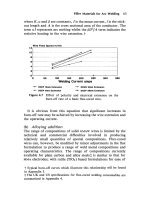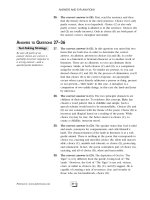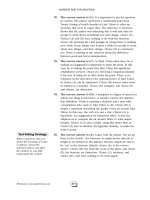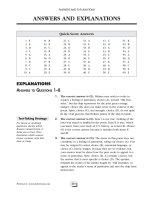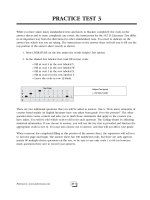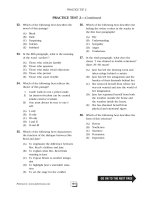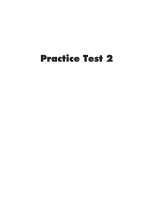SAT II success literature Episode 1 Part 5 pdf
Bạn đang xem bản rút gọn của tài liệu. Xem và tải ngay bản đầy đủ của tài liệu tại đây (110.21 KB, 20 trang )
Another important element to consider about form is genre,
which identifies the type of work a piece of fiction (or nonfiction) is,
such as a novel or short story. Within a particular genre, such as the
novella, an author may choose to create a realistic, romantic, tragic,
or comedic work in order to tell his or her story.
QUESTIONS TO HELP YOU RECOGNIZE FORM AND ITS EFFECTS IN FICTION
Consider the following to help you analyze a fictional work’s form, or
structure:
1. Summarize the plot or narrative line. What are the conflicts, the
climax, the turning point, and other important points in plot
development?
2. How are the elements of the story arranged?
3. Do the elements occur when you expect them to in relation to
the story’s plot?
4. What comes first, second, and so forth, and why?
5. How would the story be different if aspects of the plot were
presented in a different order?
6. How does the existing order contribute to the story?
7. How does the placement of elements influence the effect of the
story?
8. What is the genre of the piece?
FORM IN NONFICTION
Nonfiction, of course, is not created from the author’s imagination. It
depends on factual information, although there may be an element of
opinion, depending on the genre—personal or informal essay, for
example, versus an informational article. However, the method of
organization—form or structure—may vary greatly among a sample of
nonfiction works. The following table provides an overview of the
major ways nonfiction is organized or structured.
Note: Writers of fiction as well as poets and dramatists may use
the same organizing principles to develop the form—structure—of
their works. Although a novel may be developed overall by chrono-
logical order, a description of a character may be developed through
a comparison and contrast with another character, or the denoue-
ment of a murder mystery may be reached through developmental
order by having the detective explain step by step the suspected
character’s motive and opportunity.
CHAPTER 2: ELEMENTS OF PROSE
71Peterson’s: www.petersons.com
Organizational Patterns
Chronological order Information arranged in time sequence
Spatial order Information arranged according to space
relationships; for example, head to toe,
near to far, etc.
Order of importance/
climactic
Information arranged from least important
to most important, or vice versa
Compare and contrast Information arranged according to
similarities and differences between two
or more subjects
Developmental order Information arranged so that one point
leads logically to another
Deductive order Information arranged from general to the
specific
Inductive order Information arranged from specific to the
general
QUESTIONS TO HELP YOU DETERMINE FORM AND ITS EFFECTS IN NONFICTION
Consider the following questions as you read nonfiction selections:
1. What is the genre of the selection?
2. What organizing principle(s) did the writer use? In other words,
how is the selection ordered?
3. Is the supporting evidence sufficient? Does it address the thesis?
4. Is there any faulty reasoning? By whom? Is it intentional or
unintentional? What is its effect on the meaning?
SAT II SUCCESS: LITERATURE
72 Peterson’s SAT II Success: Literature
TONE
Tone refers to the methods and techniques that writers use to reveal
attitudes and is found in both fiction and nonfiction. You can also
consider tone the mood of a work and the devices used to create that
mood. A work may have a tone that is formal, informal, solemn,
humorous, serious, condescending, or ironic, among others. Authors
convey tone with their style, elements such as word choice, sentence
structure, and details. In addition, you can determine tone by
recognizing the writer’s intent and analyzing the writer’s comments.
The feeling a story leaves you with is an excellent indicator of tone.
IRONY
Irony, a contrast between what is and what seems to be, can be an
important indicator of tone in both fiction and nonfiction. It is often
verbal irony. A statement is made that means one thing to the
speaker but means another to you, the reader. A double entendre is a
technique used for verbal irony.
SETTING
Review Strategy
Some possible tones are
• admiration
• anger
• apathy
• approval
• contempt
• disappointment
• doubt
• hostility
• indifference
• irony
• optimism
• pessimism
• pride
• rage
• regret
• rejection
• respect
• surprise
• sympathy
Another element in fiction that affects tone is the setting. Setting can
be a place or a situation. It may be an actual geographical location,
the time when the events take place, and/or the socioeconomic
conditions that relate to the characters and to the society that
surrounds them. To determine the effect of the setting on the tone,
ask yourself the following questions:
• Are things described visually so you could draw a map or a
sketch? Or are things left vague? Why?
• What influence does the setting have on the characters of the
story?
• Does the setting bring the characters together or tear them
apart? Does it make conversation and intimacy easy or does it
inhibit it?
• What physical aspects are important to the action? How and
why are they important? How are they described?
• Are items and things important to the action? How do they
figure in the plot?
• Do characters respect or abuse the environment?
CHAPTER 2: ELEMENTS OF PROSE
73Peterson’s: www.petersons.com
TONE IN FICTION
Review Strategy
You will find a discussion of
the elements of style later in
this chapter.
When you read to identify tone, it is important to recognize that
many parts of the story contribute to the tone: situation, character,
style, and audience. To recognize tone, you need to be aware of the
general impressions that passages create for you. Analyze the tech-
niques that the writer uses to create effects. Consider situations that
prompt discussion among characters, descriptions of setting and
actions, appropriateness of style to characterization, the presence of
humor, and the attitudes of the characters.
QUESTIONS TO HELP YOU DETERMINE TONE
Ask yourself the following questions to help you identify the tone of
a work of fiction:
1. Who is the speaker?
2. What is the speaker’s tone? Is there a difference between
the speaker’s tone and that of the author?
3. How does the dialogue contribute to the tone?
4. How do the descriptions contribute to the tone?
5. How do the actions of the characters contribute to the tone?
6. How does the setting influence the tone?
7. How do the writer’s language and style affect the tone?
TONE IN WORKS OF NONFICTION
In nonfiction, tone results from the purpose of the work. The chart
below lists tones that are characteristic of each type of nonfiction.
Type of Nonfiction Tone
Expository Informative
Persuasive Reasoned, convincing
Descriptive Informative, entertaining; eliciting a
specific mood, such as exhilaration,
gloom, or amazement
Narrative Any tone appropriate to the genre and pur-
pose; for example, an autobiography may be
humorous, witty, and urbane; a biography
may be tragic, ironic, or amusing
To determine the tone of a nonfiction work, first decide upon the
author’s purpose. Using that purpose, determine the tone appropriate
for the type of writing. Use the questions suggested above for fiction
to reveal the tone for narrative and descriptive writing.
SAT II SUCCESS: LITERATURE
74 Peterson’s SAT II Success: Literature
VOICE
Review Strategy
You may also find point of
view identified as viewpoint,
unifying voice, perspective,
angle of vision, persona,
mask, center of attention,
and focus.
Point of view provides the perspective of the story; it is the voice or
speaker doing the narrating. Point of view is the way you are
presented with the materials of a story and also the vantage point
from which the writer presents the story. Think of it as the person
who is doing the talking.
This may appear to be the writer addressing you through
authorial voice. More commonly, the speaker is a character within
the story. To determine point of view, you must analyze the nature of
the speaker and recognize the character and circumstances of the
individual relating events. Point of view has often been considered
the aspect of literature that leads you to the problems and the
meaning of a work.
You can classify point of view fairly easily according to the
following categories:
• First person
If you find that a story is told by an “I,” the writer is using
first-person point of view. This does not mean that it is the
author’s voice, but rather the voice of a fictional character.
First-person speakers report the things they see, hear, and
think. As they do so, you learn about their background,
attitudes, and values.
One type of first-person speaker has learned information
through direct participation in the action. Another type has
observed the action but is not a major character. A third type
may relate what he or she has been told.
No matter which type of first-person speaker you
encounter, the speaker is an important part of the story.
Everything you learn is reported by that person. Therefore,
you must consider the speaker’s character, attitudes, interests,
and values along with everything the person says when you
analyze the story.
• Second person
You may occasionally run across a story where the reader is
addressed as “you”; it is rare. This voice assumes that the
reader is a character who lives in the narration. While
uncommon in fiction, second person is more commonly found
in informal works of nonfiction.
CHAPTER 2: ELEMENTS OF PROSE
75Peterson’s: www.petersons.com
• Third person
If the narrator is not a character in the story, can see into
each character’s mind, and understands all of the action, then
the story has a third-person point of view. The three types of
third-person point of view are:
• Omniscient
When the speaker describes the action and knows the
thoughts and feelings of all the characters, the point of
view is omniscient. While this point of view was used
in early fiction, few modern writers use it because,
since real people are not all seeing, the resulting story
will seem unrealistic.
• Limited omniscient
This voice, the most common point of view, results
when the writer uses the third person and creates one
character about whose actions, thoughts, and feelings
you know. This point of view is a favorite of contem-
porary writers.
• Dramatic objective
Also called third-person objective, this voice develops
when authors use mostly quotations and descriptions
of actions and avoid presenting inner thoughts or
feelings. Characters may express their attitudes, but
mainly you, the reader, must make your own conclu-
sions and interpretations from the actions and dialogue
described.
When you analyze point of view, you must consider all of the
following to decide the contribution to the work:
• Language
• Authority
• Opportunity for observation
• Selection of details
• Characterization
• Interpretive commentary
• Narrative development
One of the most important aspects of evaluating point of view is to
determine if the actions and speeches are reported authentically so
that the telling of the story is as true as the story itself is.
SAT II SUCCESS: LITERATURE
76 Peterson’s SAT II Success: Literature
QUESTIONS TO HELP YOU DETERMINE VOICE
Answering the following questions will help you determine the voice
of a piece of fiction:
1. Who is the main character?
2. Who is the speaker?
3. What is the attitude of the writer toward the subject of the
piece?
4. Are the speaker and the writer the same? Are the attitudes
and views of the writer and the speaker different? If so,
what effect results?
5. Does the narrative voice influence the tone? How?
ELEMENTS OF STYLE: LANGUAGE USE
Style, the way writers put words together to tell the story, develop an
argument, dramatize a play, or compose a poem, is another important
element in literary analysis. Style can be described as the placement
of words in the service of content. Jonathan Swift defined style as the
right words in the right places. Writers have distinct, individualistic
styles.
EFFECTIVE STYLE
The study of style must include diction (or word choice), types of
words, and level of difficulty of language that a writer uses. To
communicate effectively with the reader, a writer must choose words
precisely so that what the writer has to say matches what is in the
writer’s mind. If you feel that a passage works well because it
conveys an idea well or creates an event vividly, you can say that the
writer employs style effectively. Depending on the purpose of a
work, some marks of effective style are the use of
• precise words, such as action verbs, and specific rather than
general nouns;
• the word with the best connotation for the idea;
• vivid language;
• varied word choice;
• words appropriate to the audience and the purpose.
CHAPTER 2: ELEMENTS OF PROSE
77Peterson’s: www.petersons.com
In the same way, the lack of certain characteristics demonstrates
effective style, such as the lack of
• self-important or overly emotional language;
• empty or hedging words;
• redundancy and wordiness;
• clichéd and euphemistic language;
• jargon and slang.
CATEGORIES OF DICTION
When you are examining diction, word choice falls into three
categories: formal or high, neutral or middle, or informal or low.
Formal diction involves standard and elegant words, proper word
order and grammar, and lack of contractions. “It is I” would be
considered formal.
Neutral diction is ordinary, everyday language with a standard
vocabulary that does not include multisyllabic words but can include
contractions. Neutral diction would include “It’s me.”
Informal diction may be colloquial, substandard, or slang. “Yo,
dude, whatzup” belongs in this category.
SENTENCE STRUCTURE
Writers may also use sentence structure to develop style. A writer like
Ernest Hemingway made short, pithy sentences fashionable in
twentieth-century literature, whereas eighteenth- and nineteenth-
century writers like Boswell and Hawthorne used compound-complex
sentences with convoluted constructions to get their ideas across.
You may find a question or two dealing with sentence structure and
word usage on the SAT II: Literature Test. If you do, the sentence
question will probably ask you something about style and sentence
structure, and the word usage question may ask you to identify the
use of a word in a sentence rather than its meaning in context.
ANALYZING PROSE
Use the chart on the next two pages to help you analyze literary
elements of prose passages. Read it now, and then reread it after you
take each Practice Test. Use it also when you have to analyze
passages for class. The more you use it along with the other sugges-
tions in this chapter and in the “Answers and Explanations” for each
test, the more you will use the techniques automatically on exam day.
SAT II SUCCESS: LITERATURE
78 Peterson’s SAT II Success: Literature
Analyzing Prose
Mode of Discourse
1. What type of prose is it—fiction, exposition, persuasion, description, narrative, drama?
2. Are points developed by definitions, examples, facts, events, or quotations and
citations?
Author
1. Who is the author?
2. What do you know about the writer and/or the time period in which the passage
was written?
Title
1. What does the title tell you?
2. What does it suggest about the subject or the theme (meaning) of the passage?
Subject
1. What is the subject of the passage?
2. What is this selection about?
Setting
1. Where and when does the action in the selection take place?
2. What details does the writer use to create the setting?
3. Does the setting create a mood or feeling?
4. Is the setting a symbol for an important idea that the writer wants to convey?
5. Does the setting play a role in the central conflict?
Point of View
1. Is the passage told from the first-person or from the third-person point of view?
2. Is the narrator limited or omniscient?
3. What effect does the point of view have on the way you experience the selection?
Central Conflict
1. In what struggle is the protagonist involved?
2. Is the central conflict internal, within the main character’s mind, or external, with
another character, society, or nature?
3. How is the conflict resolved?
CHAPTER 2: ELEMENTS OF PROSE
79Peterson’s: www.petersons.com
Analyzing Prose—Continued
Plot or Course of Events
1. What events take place in the passage?
2. Does the piece have an introduction?
3. If so, what does the reader learn in the introduction?
4. What is the inciting incident?
5. What happens during the development?
6. When does the climax occur?
7. What events mark the resolution?
8. Does the selection have a denouement?
9. Are there special plot devices, such as a surprise ending, foreshadowing, or flashbacks?
10. If there is suspense, how does the writer create it?
Characterization
1. Who is the protagonist?
2. Who are the other major and minor characters?
3. Is there conflict among characters?
4. How does the writer reveal each of the characters?
5. Which characters change and which are flat?
Literary Devices and Figures of Speech
1. Does the writer make use of devices such as euphony or alliteration?
2. Does the passage contain any examples of figurative language, such as hyperbole,
metaphor, or simile?
3. Is there symbolism? What is it?
Theme or Thesis
1. What is the theme or central idea of the selection?
2. How is the theme conveyed?
Style
1. Are there denotative words, connotative words, abstract words, or inclusive words?
2. What is the tone?
3. What kinds of sentence structure are present?
4. How is the passage organized? What type of structure does the writer use?
NOTE: These questions are general. You will need to adapt them to the type of prose you are
reading. Some questions are more appropriate for fiction, while others work better with non-
fiction. By using them throughout this chapter, you will become so familiar with the questions
that you will know automatically which ones to use with which prose passage on the test.
SAT II SUCCESS: LITERATURE
80 Peterson’s SAT II Success: Literature
QUESTIONS TO HELP YOU IDENTIFY LANGUAGE USAGE
If the style is effectively created, you probably will not notice the
style as you read, because clear expression leads to easy reading—the
mark of a successful work. However, if you ask yourself the following
questions, you can determine the style and its effects on tone:
1. What type of passage is it—fiction or nonfiction?
2. Does it contain any dialogue (or monologue)?
3. Is there a speaker with clearly established characteristics?
Who?
4. How does the passage show the speaker’s personality?
5. What is the level of diction? Did you need a dictionary to
understand it? Are there any unusual words?
6. Did words or slang distract you?
7. Is the language intimate and conversational?
8. Could the writer have used more accurate, concrete words?
Where?
9. Can you imagine the situations described?
10. What types of sentences does the writer use? Why?
11. Are there noticeable literary devices or figurative language
used? If so, what is their effect?
CHARACTER AND CHARACTERIZATION
Character in literature generally is an extended representation of a
human being, including that person’s thoughts, behavior, and speech.
Characterization is the creation of reasonable facsimiles of human
beings. Character and characterization are the basis of fiction, but
they are also elements of biography and autobiography because in
each the writer seeks to create a portrait of a person.
A writer develops characters through dialogue, actions, and
commentary. The reader discovers characters through the interactions
of the individuals and circumstances—the choices that the characters
make. Consider each action or speech as you analyze how a writer
creates characters, because every action, interaction, conversation,
and observation exists to give you details that you need in order to
draw conclusions about the characters. As you read, ask yourself the
following questions about the characters:
CHAPTER 2: ELEMENTS OF PROSE
81Peterson’s: www.petersons.com
• What do the characters say or think?
In general, in determining the character of an individual, accept
at face value what a character says. However, be sensitive to
shifts in attitude or mood because speeches—internal and exter-
nal—can also indicate growth or change in characters.
• What actions do the characters take?
Always interpret actions as signs of character. Sometimes
actions tell you more about characters than anything they say
or anything that is said about them. Remember the cliché
“actions speak louder than words.” It is especially true in
literature. If actions contradict words, look for hypocrisy,
weakness, or change in a character.
• What do the characters say about one another?
Because stories reflect life, you will find that characters talk
about one another. If you recognize that a speaker is honest,
accept what is said about another character as true. If you
know that one character hates another, recognize the preju-
dice. Consider the context and the source of the information
when you analyze characters.
• What does the writer say about the characters?
Writers often function directly as a storyteller or observer in a
story. When you find this, you can accept what the author
says about a character as the truth. Be aware that, while you
can accept the author’s facts without question, you may need
to consider an interpretation of actions or characteristics.
QUESTIONS TO HELP YOU ANALYZE CHARACTERS
The following questions will help you determine important elements
about the characters and their characterizations:
1. What facts can you find out about the characters, such as
their names, ages, relationships to one another, stations in
life, and other important facts?
2. Which characters are the protagonist, antagonist, victims,
witnesses, heroes, anti-heroes, and so forth?
3. What are the characters’ attitudes toward one another,
toward situations or events, toward life, and so forth?
4. What do they feel? How do they react?
5. What type of characters are there? Stereotypical? Round?
Flat? Static? Changing?
6. How do you know about the characters? How did the
writer tell you about them?
SAT II SUCCESS: LITERATURE
82 Peterson’s SAT II Success: Literature
READING EFFECTIVELY: TECHNIQUES FOR THE SAT II:
PROSE SELECTIONS
Reading the selections on the SAT II: Literature Test can be a challenge.
You are working under a time limit with pressure to do well and faced
with unfamiliar material to analyze. The following suggestions will help
you read the passages and answer the questions like a pro.
READING THE SELECTIONS
• Remember to scan the selections to prioritize the order in which
you choose to answer the selections.
• Most prose passages have no titles. If a selection is titled, think
about what it tells you about the work. You may get a sense of the
subject and theme just from the title.
• If there is no title, and there probably won’t be in the prose
selections, look for the topic sentence or thesis statement. In most
writing you will find that near the beginning. However, since the
SAT II: Literature Test uses more challenging literature and often
just excerpts, you may find the topic sentence at the end or in the
middle. Often, the thesis is implied as opposed to stated outright.
• First, skim a selection for an overall impression, and then read the
selection carefully. Do not skip over confusing sentences.
• As you read, highlight words and sentences that seem significant.
Circle, underline, or bracket them. However, don’t spend a lot of
time at this.
• When you read a passage, keep in mind the five W’s and H: who,
what, where, when, why, and how. Answers to these questions will
help you to recall specific information about a selection.
• As you read, observe patterns of organization the writer employs.
Patterns may follow a certain sequence or order, set up a compare-
and-contrast situation, or offer a problem and solution. Some
authors may use more than one system of organization.
• Mentally paraphrase the prose passages that you read. Paraphrasing
helps you discover the subject and the organization of the selec-
tion. You will discover the thesis and supporting arguments. The
writer’s style, transitions, sentence types, language, and literary
devices become clear. You can see the framework of the passage in
a paraphrase. If paraphrasing does not come easily to you, try
writing paraphrases of the selections in this book as you practice.
• Look for the main idea of the passage. It’s the central point. If you
paraphrased well, the main idea will come easily.
CHAPTER 2: ELEMENTS OF PROSE
83Peterson’s: www.petersons.com
ANSWERING THE QUESTIONS
Test-Taking Strategy
If you do not answer the
questions in order, be sure to
circle on the test booklet the
numbers of the questions
you do not answer. Do not
make any “stray marks” on
the answer sheet.
• Just as you chose the order in which to attack the passages, choose
the order in which you wish to answer the multiple-choice questions.
If you understand the passage, answer the questions in order.
• When answering a theme or main-idea question, the correct choice
must be entirely true and include as much relevant information as
possible. In many questions, two or three choices might be correct.
However, the answer that is most complete is the one to choose.
Check to see if answers that seem correct are really supporting
details to a broader answer choice.
• Pay attention to word choice when you have to answer a question
about tone or purpose. You must determine how or why the writer
created the selection. Authors convey that information through dic-
tion.
• When you are asked to make judgments about what is inferred or
implied in a selection, you must put together clues from the
passage. You must be able to support your answer with specific
facts or examples before you select an answer choice.
• Questions that ask about the meaning of words or phrases are best
answered by substituting your choice into the sentence or para-
graph. The answer must make sense before you choose it.
Review Strategy
Use the techniques presented
in “Strategies for Answering
Objective Questions/Making
Educated Guesses,” page 60,
to reduce the number of
possible choices you have.
• Reread lines, sentences, or paragraphs that are mentioned in
questions. In fact, scan or reread any selection if you do not know
the answer immediately.
• If you are not confident, skip difficult questions and answer the
easy ones first. If you do skip questions, check to be sure you also
skipped that number on your answer sheet.
• Many times the key to finding the correct answer is to narrow
down the choices and make an intelligent guess. Eliminate some
answers by finding those that are obviously unrelated, illogical, or
incorrect. Then, you can make good educated guesses.
SAT II SUCCESS: LITERATURE
84 Peterson’s SAT II Success: Literature
PRACTICING
The following selection and questions are very similar to those you
will find on the actual SAT II: Literature Test. As you read the
selection and answer the questions, apply the suggestions and
strategies that you just learned. Jot down your answers to the
questions in the margins or on a separate sheet of paper.
You may refer to the answers question by question, or you may
wish to score the entire section at one time. However, if you do not
understand a question, check the explanation immediately. No matter
which method of checking the answers you use, be sure to read all
the explanations. The reasoning involved may point out concepts or
details that you missed, and the explanations will show you how the
strategies can work for you. The selection is not easy, so you may not
be able to answer every question correctly. That is why it is good
practice.
CHAPTER 2: ELEMENTS OF PROSE
85Peterson’s: www.petersons.com
Directions: This test consists of selections of literature and
questions on their content, style, and form. After you have read
each passage, choose the answer that best answers the question
and fill in the appropriate oval on the answer sheet.
Note: Read each question carefully, paying particular attention
to those that contain the words not, least, or except.
Questions 1–12 refer to this selection written by Thomas Paine, the
colonial writer and radical. Read the selection carefully and then
answer the questions.
Line These are the times that try men’s souls. The summer soldier and the
sunshine patriot will in this crisis, shrink from the service of his
country; but he that stands it NOW, deserves the love and thanks of
man and woman. Tyranny, like hell, is not easily conquered; yet we
have this consolation with us, that the harder the conflict, the more
glorious the triumph. What we obtain too cheap, we esteem too
lightly, ‘tis dearness only that gives everything its value. Heaven
knows how to put a proper price upon its goods; and it would be
strange indeed, if so celestial an article as FREEDOM should not be
highly rated. Britain, with an army to enforce her tyranny, has
declared that she has a right (not only to TAX) but “to BIND us in
ALL CASES WHATSOEVER,” and if being bound in that manner, is not
slavery, then is there not such a thing as slavery upon earth. Even the
expression is impious, for so unlimited a power can belong only to
God
I have as little superstition in me as any man living, but my
secret opinion has ever been, and still is, that God Almighty will not
give up a people to military destruction, or leave them unsupportedly
to perish, who have so earnestly and so repeatedly sought to avoid
the calamities of war, by every decent method which wisdom could
invent. Neither have I so much of the infidel in me, as to suppose
that he has relinquished the government of the world, and given us
up to the care of devils; and as I do not, I cannot see on what
grounds the king of Britain can look up to heaven for help against us:
a common murderer, a highwayman, or a housebreaker, has as good
a pretense as he
I once felt all that kind of anger, which man ought to feel,
against the mean principles that are held by the Tories: a noted one,
who kept a tavern at Amboy, was standing at his door, with as pretty
a child in hand, about eight or nine years old, as I ever saw, and after
speaking his mind as freely he thought was prudent, finished with the
unfatherly expression, “Well! give me peace in my day.” Not a man
SAT II SUCCESS: LITERATURE
5
10
15
20
25
30
86 Peterson’s SAT II Success: Literature
lives on the continent but fully believes that a separation must some
time or other finally take place, and a generous parent should have
said, “If there must be trouble let it be in my day that my child may
have peace”; and the single reflection, well applied, is sufficient to
awaken every man to duty. Not a place upon earth might be so
happy as America. Her situation is remote from all the wrangling
world, and she has nothing to do but trade with them. A man can
distinguish himself between temper and principle, and I am as
confident, as I am that God governs the world, that America will
never be happy till she gets clear of foreign dominion. Wars, without
ceasing, will break out till that period arrives, and the continent must
in the end be conqueror; for though the flame of liberty may some-
times cease to shine, the coal can never expire
I turn with the warm ardor of a friend to those who have nobly
stood, and are yet determined to stand the matter out: I call not upon
a few, but upon all; not on this state or that state, but on every state;
up and help us; lay your shoulders to the wheel; better have too
much force than too little, when so great an object is at stake. Let it
be told to the future world, that in the depth of winter, when
nothing but hope and virtue could survive, that the city and the
country, alarmed at one common danger, came forth to meet and to
repulse it. Say not that thousands are gone, turn out your tens of
thousands; throw not the burden of the day upon Providence, but
“show your faith by your works,” that God may bless you. It matters
not where you live, or what rank of life you hold, the evil or the
blessing will reach you all. The far and the near, the home counties
and the back, the rich and the poor, will suffer or rejoice alike. The
heart that feels not now, is dead: the blood of his children will curse
his cowardice, who shrinks back at a time when a little might have
saved the whole, and made them happy. (I love the man that can
smile at trouble; that can gather strength from distress, and grow
brave by reflection.) ‘Tis the business of little minds to shrink; but he
whose heart is firm, and whose conscience approves his conduct,
will pursue his principles unto death. My own line of reasoning is to
myself as straight and clear as a ray of light. Not all the treasures of
the world, so far as I believe, could have induced me to support an
offensive war, for I think it murder; but if a thief breaks into my
house, burns and destroys my property, and kills or threatens to kill
me, or those that are in it, and to “bind me in all cases whatsoever,”
to his absolute will, am I to suffer it? What signifies it to me, whether
he who does it is a king or a common man; my countryman, or not
my countryman; whether it be done by an individual villain or an
army of them? If we reason to the root of things we shall find no
difference; neither can any just cause be assigned why we should
punish in the one case and pardon in the other.
CHAPTER 2: ELEMENTS OF PROSE
35
40
45
50
55
60
65
70
75
87Peterson’s: www.petersons.com
1. What is the best meaning for the word
“mean” in line 28?
(A) Inferior
(B) Small minded
(C) Selfish
(D) Miserly
(E) Bad tempered
2. In the sentence beginning “My own line of
reasoning” (line 66), which figure of
speech does the author employ?
(A) Consonance
(B) Analogy
(C) Simile
(D) Metaphor
(E) Figurative language
3. Which of the following is not an example
of the contrasts that Paine sets up in this
excerpt?
(A) “the harder the conflict, the more
glorious the triumph” (lines 5–6)
(B) “I call not upon a few, but upon all”
(lines 47–48)
(C) “why we should punish in the one
case and pardon in the other” (lines
76–77)
(D) “I cannot see on what grounds the
king of Britain can look up to
heaven” (lines 23–24)
(E) “though the flame of liberty may
sometimes cease to shine, the coal
can never expire” (lines 44–45)
4. Which of the following best describes the
tone of this passage?
(A) Reasonable
(B) Angry
(C) Moral
(D) Bitter
(E) Passionate
5. Which of the following best describes the
device most in evidence in this essay?
(A) Aphorism
(B) Allegory
(C) Analogy
(D) Allusion
(E) Alliteration
6. The author develops all of the following
points EXCEPT:
(A) America’s liberty is at stake.
(B) America must go to war.
(C) America’s cause is just.
(D) America must declare its indepen-
dence.
(E) America must fight all tyranny
7. To what does Paine compare Britain’s
actions toward its colonies?
(A) Tyranny and hell
(B) Murder and death
(C) Slavery and thievery
(D) Cowardice and villainy
(E) Calamity and calumny
8. In the sentence beginning “I turn with the
warm ardor” (line 46), what is the best
meaning for the word “ardor”?
(A) Glow
(B) Passion
(C) Interest
(D) Odor
(E) Energy
9. Given the passage as a whole, which of
the following best characterizes the theme
of this piece?
(A) There will always be war.
(B) God will not allow the just to perish.
(C) War is permitted against tyranny.
(D) Just wars and unjust wars are
different.
(E) All war is the same as murder.
SAT II SUCCESS: LITERATURE
88 Peterson’s SAT II Success: Literature
10. How does the writer view America’s role
in the world without Britain?
I. A melting pot
II. An independent trader
III. A happy place
(A) I only
(B) II only
(C) III only
(D) I and II
(E) II and III
11. What does Paine mean when he refers to
“the summer soldier” (line 1) and “the
sunshine patriot” (line 2)?
(A) Those who are brave only in times of
peace
(B) Soldiers who run from battle
(C) People who fade when the going gets
tough
(D) People who do not stand against
Britain’s tyranny
(E) Americans who align themselves with
the Tories
12. What is the function of the first sentence
of the essay?
(A) To demand the reader’s attention
(B) To identify with the writer’s audience
(C) To express the writer’s own frustration
(D) To present the subject of the essay
(E) To set a religious tone
CHAPTER 2: ELEMENTS OF PROSE
89Peterson’s: www.petersons.com
Quick-Score Answers
1. C
2. C
3. D
4. E
5. A
6. E
7. C
8. B
9. D
10. E
11. D
12. B
ANSWERS AND EXPLANATIONS
Test-Taking Strategy
For word meaning questions,
substitute each answer
choice into the sentence. Also
read a few lines above and
below the cited word to
determine its context.
1. The correct answer is (C). This question is a bit tricky, in that
all of the choices might reasonably fit. Given that, you have to
determine the context to help you decide on the best answer.
Paine finishes the sentence by relating an anecdote in which he
uses the phrase “a more generous parent” to show that the man
in Amboy seems to care only for peace in his time rather than in
his daughter’s time. In the context, choice (C), selfish, is the
best answer. The other responses, inferior, choice (A); small
minded, choice (B); miserly, choice (D); and bad tempered,
choice (E), do not fit.
2. The correct answer is (C). Did you recognize the simile in this
sentence? When you see a comparison and the words as or like,
it is probably a simile. Because of the presence of the word as,
figurative language, choice (E), is too general an answer and
incorrect. A simile is a type of figurative language, and in this
case, the specific answer is better than the general answer. An
analogy, choice (B), is a comparison of two similar but different
things; only one item is being compared in the sentence, so
choice (B) can be eliminated. A metaphor, choice (D), refers to
one thing as another; this is not true in this sentence, so choice
(D) can be eliminated. Choice (A) could be eliminated immedi-
ately because consonance is a figure of sound, not of speech,
and the question asks for a figure of speech. Did you note this
distinction when you read the question?
Review Strategy
Highlight by circling,
underlining, or bracketing
the key words in questions to
make sure you know what
you are looking for in an
answer choice.
3. The correct answer is (D). First, did you recognize that this
was a not/except question, so you had to look for the answer
choice that was not true? The correct answer will be the one
that does not express contrasting ideas. Choice (A), harder
conflict/more glorious triumph; choice (B), not a few/but all;
choice (C), punish/pardon; and choice (E), may cease to
shine/never expire all set up opposites. Only choice (D) does
not have a contrast within the sentence. Do not be distracted by
the use of the words “cannot see” and “look up.” They are part
of a simple statement of Paine’s view of the king. There is no
internal tension created in the line.
SAT II SUCCESS: LITERATURE
90 Peterson’s SAT II Success: Literature
